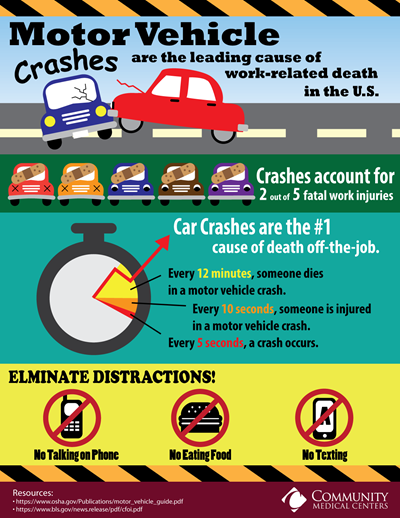 The National Safety Council defines defensive driving skills as “driving to save lives, time, and money, in spite of the conditions around you and the actions of others."
The National Safety Council defines defensive driving skills as “driving to save lives, time, and money, in spite of the conditions around you and the actions of others."Defensive Driving goes beyond the mastery of the rules of the road and basic mechanics of driving. Defensive Driving is about anticipating dangerous situations, watching for adverse conditions, and forecasting mistakes of other drivers. I would equate “driving by intuition” instead of driving by the letter of the law. The sign may say you can go 45 miles per hour, but should you?
Did you know that motor vehicle crashes are the leading cause of work-related death in the United States? Crashes accounted for 2 out of every 5 fatal work injuries in 2013. Additionally, motor vehicle crashes are also the number 1 cause of death off-the-job. In fact, every 12 minutes someone dies in a motor vehicle crash; every 10 seconds an injury occurs; and every 5 seconds a crash occurs.
Employees are the organization’s most valuable assets. Any accident is a tragedy, but even more so, the real tragedy is that most accidents are preventable. Community Medical Centers has made an equal commitment to both patient and employee safety. Because of this, Community has adopted a Safe Driving Policy and now requires Defensive Driving training for anyone who drives on work time. In this training employees will learn how to recognize hazardous situations and reduce their risk of a motor vehicle accident. Some of these techniques may surprise you. For instance, if you are being tailgated you should slow down and increase your following distance between you and the car in front of you. This helps increase your cushion of safety. The area around your vehicle you can best control is in the front. Usually, the impatient driver behind you will move over and pass you when they realize they will not make you drive faster by following too closely.
The more time you spend in your vehicle, the greater your chance for an accident to occur. I want to encourage all of you to eliminate distractions while you drive including cell phones, eating, and certainly texting while driving. If you would like more information or have a suggestion for another safety topic for me to blog about, please send me an email at nozburn@communitymedical.org.
Nicole Ozburn, PHR, SHRM-CP
Director of Benefits and Compensation, Occupational Safety Officer
Community Medical Centers


